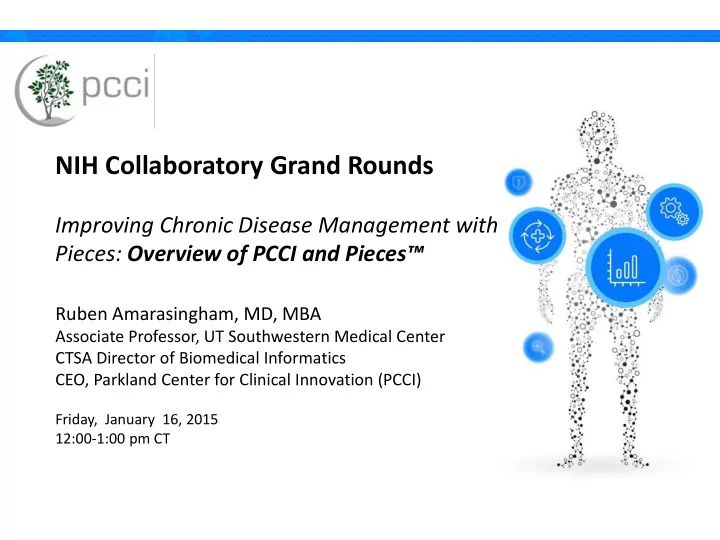

NIH Collaboratory Grand Rounds Improving Chronic Disease Management with Pieces: Overview of PCCI and Pieces™ Ruben Amarasingham, MD, MBA Associate Professor, UT Southwestern Medical Center CTSA Director of Biomedical Informatics CEO, Parkland Center for Clinical Innovation (PCCI) Friday, January 16, 2015 12:00-1:00 pm CT
Objectives • What is electronic health predictive analysis (e-HPA)? PCCI’s work in this area: Pieces™ software • • Application of Pieces™ in the CKD Pilot Study and ICD-Pieces trial • Pieces™ in Community Health Information Exchanges
What Clinicians Do in Medicine: Prediction 1. What does this patient have? 2. What will this patient develop? 3. What will be the effect of a given therapy?
Prediction in the Context of Modern Medicine 150 1900: 150 years 135 120 Doubling Time of Medical Knowledge 105 90 75 60 45 30 15 1 1900 1920 1940 1960 1980 2000 2020 2040 2060 2080 2100 Year
Prediction in the Context of Modern Medicine 150 135 120 Doubling Time of Medical Knowledge 105 90 75 60 45 30 We are here: 1 year 15 1 1900 1920 1940 1960 1980 2000 2020 2040 2060 2080 2100 Year
Prediction in the Context of Modern Medicine 150 • Staggering increase in medical information 135 • Increasing volume of decisions at multiple levels 120 • High fragmentation of care Doubling Time of Medical Knowledge • Increasing capacity for error 105 90 75 60 45 30 We are here: 1 year 15 1 1900 1920 1940 1960 1980 2000 2020 2040 2060 2080 2100 Year
Some Definitions Clinical risk prediction models : defined as models that “combine a number of characteristics (e.g. related to the patient the disease or treatment) to predict a diagnostic or prognostic outcome” [Steyerberg 2009] Electronic health care predictive analytics (e-HPA) : the technologies or software systems that can autonomously employ – and sometimes re- engineer, modify, or update – these models” [Amarasingham 2014] 7
PCCI Organizational Background A 501c(3) non-profit research and development corporation specializing in the development of clinical prediction and surveillance software to help prevent adverse clinical events.
PCCI Scientific Funding for Predictive Modeling
Every Adverse Event has a Timeline Hours 30 days 90 days Years Cardio-Pulmonary Arrest Sepsis Readmissions Asthma Complications Short-Term Preventable Diabetic Complications Hospitalizations Triad: diabetes, hypertension, CKD
Every Adverse Event has a Timeline 3 0 Days 9 0 Days Adm ission Discharge 24 hours
Preventing Heart Failure Readmissions 3 0 Days 9 0 Days Adm ission Discharge 24 7 hours days ID Risk List Orders 1 2 3 4 Evaluation & Improvement 6 Inpatient Intervention Outpatient Intervention 5 5 EMR Pieces
Identification of HF patients in Real-Time Using Natural Language Processing and Data Mining
Natural Language Processing “68 yo WF presents with acute on chronic non ischemic systolic and diastolic chf, severely depressed ef and grade ii diastolic dysfunction. ” Disease/ Symptom Time Attribute current and • Systolic, significant Acute Heart Failure depression in ejection primary fraction; • Diastolic dysfunction, grade 2 • Non-ischemic Chronic Heart Failure historic
System calculates risk for readmission
Identifying High-Risk Patients in Real-Time 70 Derivation Samples Validation Samples * 60 51.65 30-Day Readmission (%) 45.68 50 40 26.93 26.0 30 19.98 17.94 16.08 20 14.27 12.22 8.77 10 0 Very Low Low Intermediate High Very High Predicted Readmission Risk Category Amarasingham et al, Medical Care, 2010
Pieces provides list of targeted high risk patients
Activation of Clinical Pathways in the EMR
Pieces tracks interventions in the EMR
Pieces monitors outcomes
Complexities of Predictive Modeling in Healthcare
The Complexities of Predictive Modeling 1. Interventions for highest risk patients * 2. Considering clinical vs. social risk 3. Explanation vs. Prediction 4. Non-health care data sources * 5. Changing EMR data models 6. Changing clinical interventions 7. Changing populations Amarasingham et al, Health Affairs, 2014
Amarasingham et al, BMJ, 2013 • Concentrated care management efforts on ¼ of the patients • 26% relative reduction in odds of readmission • Absolute reduction of 5 readmissions per 100 index admissions
A Different Hospital: Readmission Performance
NIH-Funded CKD Pilot Study Last follow-up Screening visit Clinical Measurement % at Goal % at Goal P-value n=107 n=107 (McNemar’s test) Follow-up duration, month 11.2 [0.2 – 21.5] median [range] Systolic blood pressure 34.6% 44.0% 0.14 Diastolic blood pressure 57.9% 66.1% 0.17 ACEI/ARB 57.8% 87.2 <.0001 Statin 45.0% 79.8 <.0001 if positive test for proteinuria or albuminuria, then goal BP <130/80; Otherwise goal BP < 140/90).
ICD-Pieces Study Sites
Connecting the Community: WW Caruth
Connecting the Community: WW Caruth • Leverages predictive and prescriptive analytics on medical and social data to identify at risk individuals
Thank You!
Questions Contact Information: Ruben Amarasingham – ruben.amarasingham@phhs.org www.pccipieces.org
Recommend
More recommend